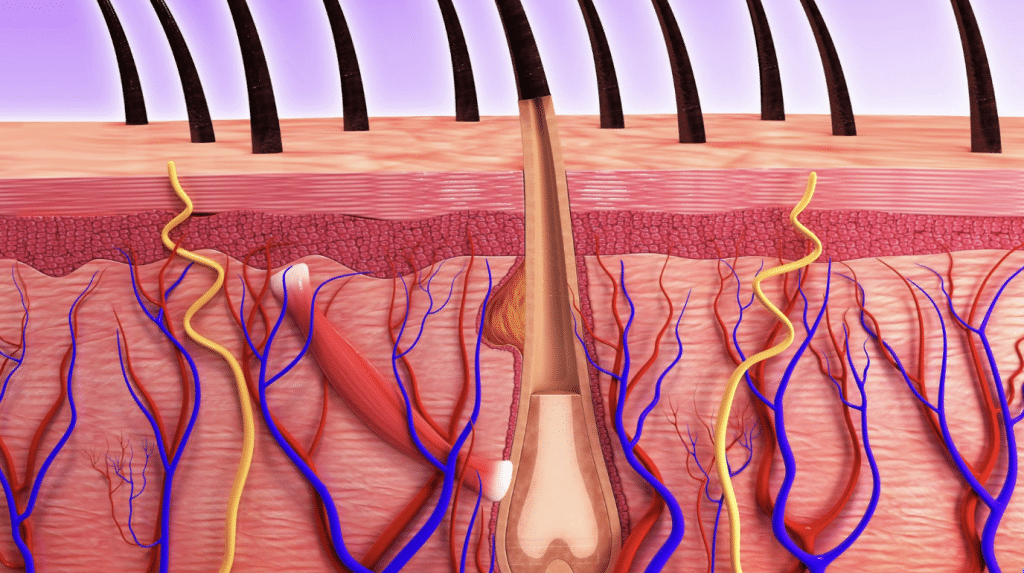Hair loss affects millions of people worldwide, with studies showing that up to 50% of men and women experience some degree of hair thinning by the age of 50. This common condition can significantly impact self-esteem and quality of life, prompting many to seek effective treatments.
Bimatoprost, originally developed for glaucoma, has shown promise in promoting hair growth. Known for its success in enhancing eyelash length and thickness, researchers are now exploring its potential to stimulate scalp hair follicles and combat hair loss.
In this article, we will delve into how Bimatoprost works, its effectiveness, and what you need to know before considering it as a treatment option for hair loss.
Key Takeaways
- Bimatoprost, originally developed for glaucoma, has shown promise in promoting hair growth and is being explored for its potential in combating hair loss.
- The unique mechanism of action of Bimatoprost works by activating prostaglandin receptors involved in hair growth, prolonging the active growth phase of hair follicles.
- Bimatoprost has demonstrated efficacy in promoting hair growth and managing ocular conditions, showing promising results compared to other hair loss treatments like minoxidil and finasteride.
- Bimatoprost is typically applied topically to the scalp or other areas of hair thinning once daily, with initial improvements in hair density and growth seen within 8 to 12 weeks of regular use.
- While generally well-tolerated, common side effects of Bimatoprost for hair loss include eye redness, itching, skin darkening, and unwanted hair growth in unintended areas if the solution spreads. Proper application techniques can help minimize these side effects.
About: Medical Spa RX provides medical practices with premium products at the best prices. If you’re looking to buy Bimatoprost Products for your practice, the sales representatives at Medical Spa RX can give you guidance.
How Bimatoprost Affects Hair Follicles

Bimatropost, widely recognized for its use in eye drops to treat glaucoma, has a unique mechanism of action (MOA) that also makes it effective for hair loss. The Bimatoprost MOA works by activating prostaglandin receptors involved in hair growth. This activation prolongs the anagen phase, which is the active growth phase of hair follicles, allowing hair to grow longer and thicker.
By extending the anagen phase, Bimatoprost eye drops help keep hair follicles in the growth stage for an extended period, leading to increased hair density and reduced hair shedding. This continuous stimulation is crucial for achieving noticeable improvements in hair volume and coverage.
One of the standout benefits of Bimatoprost for hair loss is its ability to promote thicker and longer hair. Clinical studies show that regular application can significantly improve hair thickness and length, making Bimatoprost an attractive option for those looking to enhance their hair’s overall appearance and health.
Research on Bimatoprost’s Effectiveness

Recent studies have demonstrated the efficacy of Bimatoprost in promoting hair growth, particularly for conditions like eyelash hypotrichosis. Clinical trials have shown that Bimatoprost 0.03% solution significantly improves eyelash length, thickness, and darkness.
Additionally, a study on the Bimatoprost implant indicated its effectiveness in reducing intraocular pressure (IOP) in glaucoma patients, with sustained results over several months. These findings highlight bimatoprost’s potential in stimulating hair growth and managing ocular conditions.
Most of the patient experiences are positive. Below are some of them sharing what happened after they used Bimatoprost for eyelashes:
- “Eyelashes are beautiful! You must be careful where you touch the brush. After applying, I was hitting the outside of my face (by eye), and I grew hair there. No biggie, if you stop it goes away, just like eyelashes, if you stop, they go back to how they were pre-latisse.”
- “I have used Latisse often for years, and it has always worked for me. My eyelashes get so long and thicker. I love it.”
Application Methods and Potential Results

Bimatoprost is typically applied topically to the scalp or other areas of hair thinning using a sterile applicator. The solution should be carefully applied directly to the skin, avoiding contact with unintended areas to prevent unwanted hair growth.
- Frequency of Use: Bimatoprost should be applied once daily, usually in the evening. Consistent application is essential for achieving the best results, as irregular use may reduce the effectiveness of the treatment.
- Expected Timeline for Results: Most users begin to see initial improvements in hair density and growth within 8 to 12 weeks of regular use, with more significant changes typically observed around 16 weeks. Continued use is necessary to maintain the results, as hair growth may revert to its original state if the treatment is discontinued.
Safety Considerations and Side Effects
While Bimatoprost is generally well-tolerated, some common side effects include:
- Eye redness
- Itching
- Skin darkening around the application area
- Unwanted hair growth in unintended areas if the solution spreads
To minimize these side effects, it’s important to follow proper application techniques. Ensure that Bimatoprost is applied only to the targeted regions and avoid contact with the eyes and other facial areas. Adhering to Bimatoprost warnings and usage guidelines can significantly reduce the risk of adverse effects.
Before using Bimatoprost for hair loss, consult a healthcare professional to determine if it’s the right treatment for you. Regular checkups will help monitor your progress and allow for any necessary adjustments to ensure safe and effective use.
Conclusion
Bimatoprost offers a promising option for managing hair loss by encouraging hair follicles to enter and remain in the growth phase longer, potentially leading to thicker and fuller hair for individuals with alopecia.
However, further research is necessary to fully understand its benefits and potential risks. Given the possible side effects, consulting with a healthcare professional before starting treatment is essential to ensure safety and suitability.
FAQs
1. What is Bimatoprost?
Bimatoprost is a medication primarily used to treat glaucoma and ocular hypertension by reducing intraocular pressure. It is also used cosmetically to enhance eyelash growth.
2. How does Bimatoprost impact the hair follicles?
Bimatoprost impacts hair follicles by extending the growth phase (anagen phase), which promotes longer, thicker, and darker hair growth. It is particularly effective for enhancing eyelashes and eyebrows.
3. Is Bimatoprost safe to use for all types of hair loss?
Bimatoprost is primarily effective and safe for eyelash and eyebrow growth but is not universally recommended for all types of hair loss. It’s important to consult a healthcare professional to determine its suitability for your specific condition.
4. What side effects should I watch out for when using Bimatoprost?
When using Bimatoprost, watch out for side effects like eye redness, itching, dryness, darkening of the eyelid skin, and increased brown pigmentation in the iris. If you experience any severe reactions, consult your healthcare professional immediately.
References
D E. Hair Loss Statistics 2024 (Types, Treatments…). Medihair. Published August 22, 2024. https://medihair.com/en/hair-loss-statistics/
Khidhir, K. G., Woodward, D. F., Farjo, N. P., Farjo, B. K., Tang, E. S., Wang, J. W., Picksley, S. M., & Randall, V. A. (2013). The prostamide-related glaucoma therapy, bimatoprost, offers a novel approach for treating scalp alopecias. FASEB journal : official publication of the Federation of American Societies for Experimental Biology, 27(2), 557–567. https://doi.org/10.1096/fj.12-218156\
Jha, A. K., Sarkar, R., Udayan, U. K., Roy, P. K., Jha, A. K., & Chaudhary, R. K. P. (2018). Bimatoprost in Dermatology. Indian dermatology online journal, 9(3), 224–228. https://doi.org/10.4103/idoj.IDOJ_62_16





















